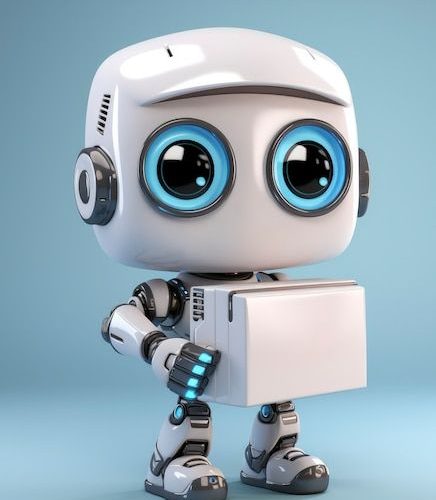When most people think of robots, they imagine futuristic machines with metallic limbs or intelligent humanoids from science fiction. However, robotics is no longer confined to movies or labs. It’s now an essential part of our daily lives, quietly working behind the scenes or assisting us in visible ways.
From cleaning our homes to performing complex surgeries, robots are reshaping how we live, work, and interact with the world. In this blog, we’ll explore the role of robotics in daily life, highlighting how these intelligent machines are transforming various aspects of modern living.
🏠 Robotics at Home: Making Life Easier
One of the most noticeable impacts of robotics is in the household. Modern homes are becoming “smart” thanks to robotic technologies that automate mundane tasks.
1. Robot Vacuum Cleaners
Devices like Roomba and Eufy have changed the way we clean our homes. These small, disc-shaped robots can detect dirt, avoid obstacles, and even return to their charging stations on their own. They save time and effort, especially for busy families or individuals with mobility issues.
2. Robotic Lawn Mowers
Just like robot vacuums, robotic lawn mowers can trim your lawn without supervision. They’re equipped with sensors and timers, allowing you to enjoy a perfectly cut lawn without lifting a finger.
3. Smart Home Assistants
While not “robots” in the traditional sense, AI-driven devices like Amazon Alexa and Google Assistant use robotic principles to automate daily tasks like turning off lights, playing music, or setting reminders. They’re becoming central to smart homes.
🏥 Robotics in Healthcare: Saving Lives
The field of medicine and healthcare has been greatly enhanced by robotic innovations. Precision, efficiency, and the ability to perform repetitive or complex tasks have made robots essential in hospitals.
1. Surgical Robots
Systems like the Da Vinci Surgical System allow surgeons to perform delicate operations with extreme precision. These robots translate the surgeon’s hand movements into smaller, more accurate actions, reducing risks and recovery time for patients.
2. Robotic Prosthetics
Advanced prosthetic limbs controlled by the user’s brain signals or muscle movements are giving amputees a new level of independence. These robotic limbs can mimic natural movement and even provide feedback through sensors.
3. Medication Delivery Robots
In hospitals, robots are being used to deliver medication, transport lab samples, and assist with sanitization—freeing up medical staff to focus on critical care.
🏭 Industrial Robotics: Revolutionizing Manufacturing
The industrial sector was one of the first to adopt robotics on a large scale. Robotic arms, conveyor bots, and automated machines have been transforming production lines for decades.
1. Assembly Line Robots
In automotive and electronics factories, robots handle welding, painting, and assembly with speed and precision. They work 24/7, increasing efficiency and lowering costs.
2. Warehouse Automation
Companies like Amazon use robots to manage inventory, pick and pack items, and deliver products within facilities. This not only speeds up processes but also improves accuracy and safety.
3. Quality Control
Robots with cameras and sensors are now used to inspect products for defects. Unlike humans, they don’t get tired or make errors due to fatigue.
🚗 Robotics in Transportation
From self-driving cars to drones, robotics is revolutionizing how we travel and transport goods.
1. Autonomous Vehicles
Companies like Tesla, Waymo, and others are investing heavily in autonomous vehicles. These cars use sensors, AI, and robotics to navigate roads without human input—potentially reducing accidents and improving traffic efficiency.
2. Delivery Drones and Robots
Robotic couriers and drones are now being tested to deliver groceries, packages, and even medical supplies. In some urban areas, these autonomous bots are already in operation.
📚 Robotics in Education and Entertainment
Robotics isn’t just about work—it’s also enhancing how we learn and play.
1. Educational Robots
Many schools are introducing STEM-based robotic kits like LEGO Mindstorms or Sphero to help students learn coding, engineering, and problem-solving in a fun and interactive way.
2. Social and Companion Robots
Robots like Sony’s Aibo (robotic dog) and Jibo (a social robot) are being used for companionship, especially among children and the elderly. They can recognize faces, respond to emotions, and even tell jokes.
👵 Robotics for the Elderly and Disabled
Robots are proving to be a lifeline for elderly and disabled individuals by enhancing their independence.
-
Assistive robots can help with tasks like eating, dressing, or medication reminders.
-
Telepresence robots allow seniors to stay in touch with family and doctors without leaving home.
-
Exoskeletons, wearable robotic suits, help people with spinal injuries or muscle weakness regain movement.
🌍 The Future of Robotics in Daily Life
As technology advances, robotics will become even more integrated into our lives. We can expect:
-
More intelligent home robots that can cook, fold laundry, and provide companionship.
-
Advanced AI integration, making robots capable of understanding emotions and adapting to human behavior.
-
Wider use of robots in disaster relief, agriculture, and environmental conservation.
However, with these advancements come challenges—ethical concerns, job displacement, and the need for proper regulation and education about the safe use of robotics.
Final Thoughts
Robotics is no longer a futuristic dream—it’s a present-day reality shaping how we live, work, and interact. From cleaning our homes to aiding in life-saving surgeries, robots are becoming silent partners in our everyday routines.
As we continue to embrace innovation, the role of robotics in daily life will only grow. The key is to use this technology wisely, ensuring it enhances our quality of life and supports a better future for all.












